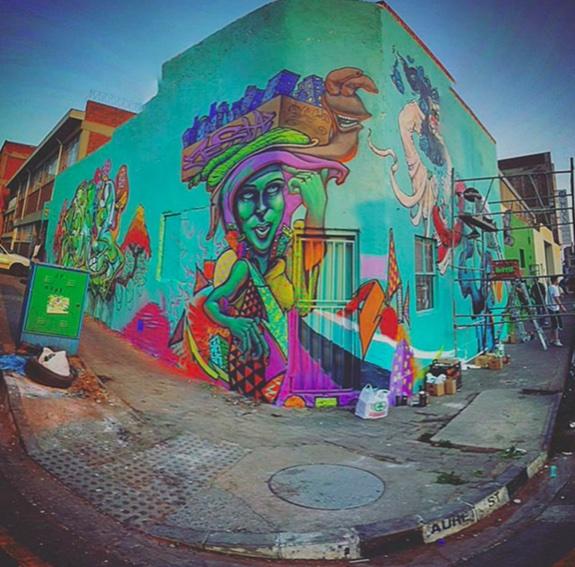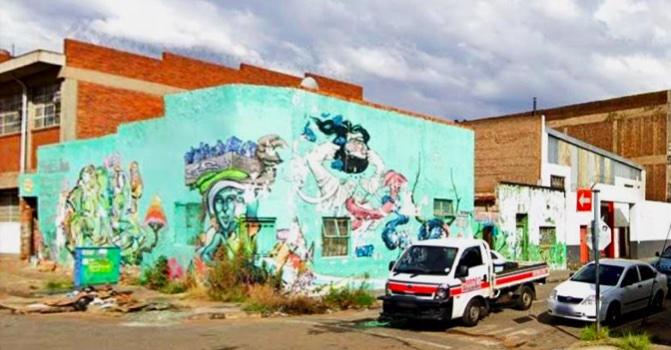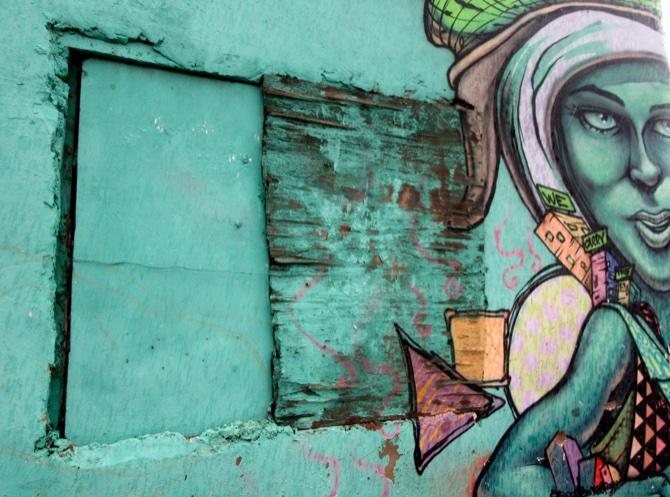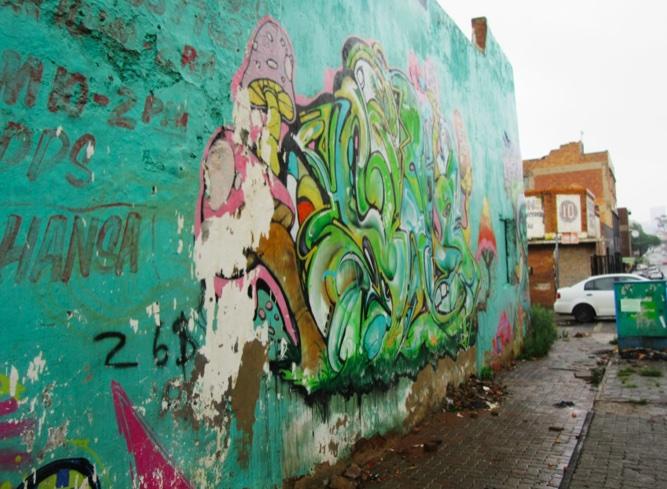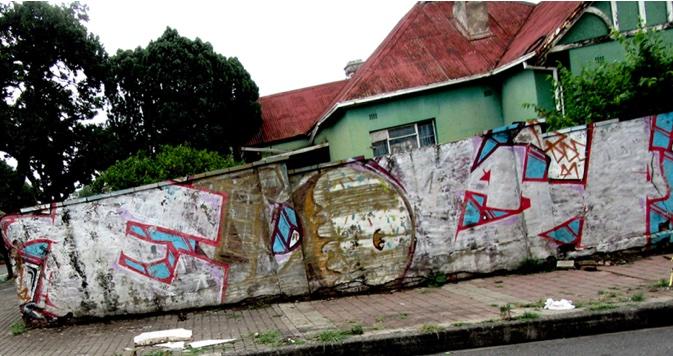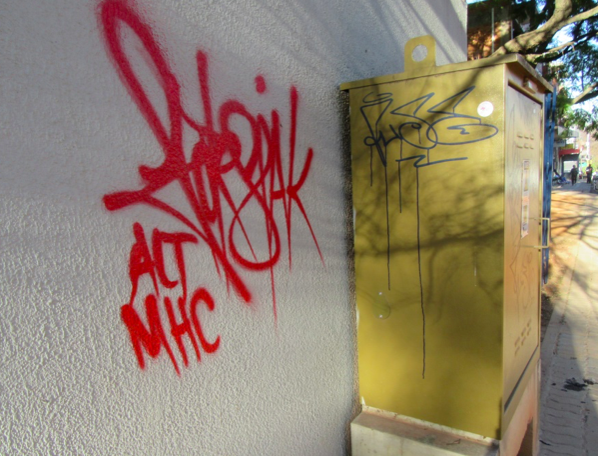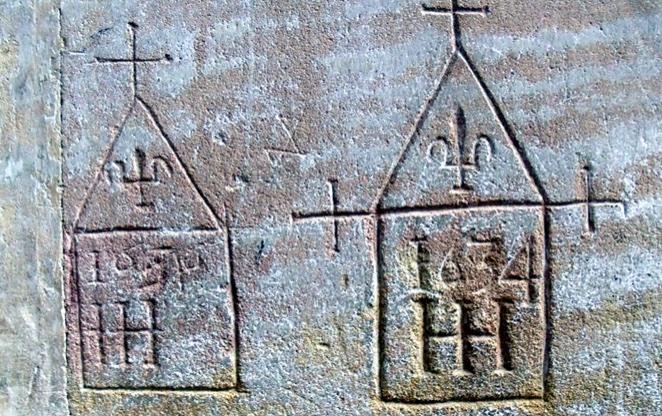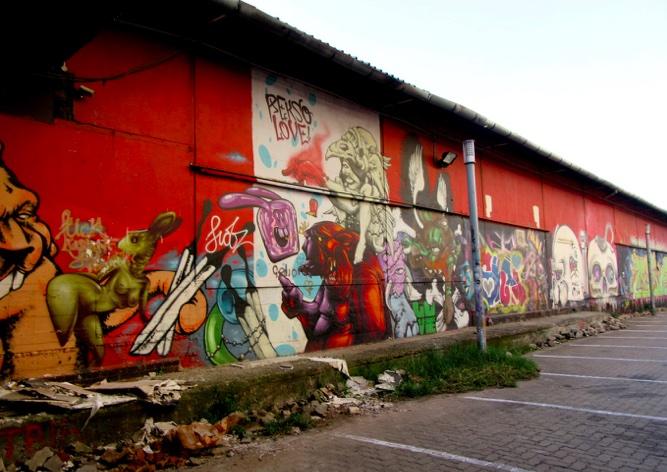
Disclaimer: Any views expressed by individuals and organisations are their own and do not in any way represent the views of The Heritage Portal. If you find any mistakes or historical inaccuracies, please contact the editor.
Each year since 2011, walls in Newtown, Jeppestown and the Johannesburg CBD have been decorated by both international and local graffiti artists who are invited to decorate designated buildings with high-quality graffiti and wall art. The annual graffiti festival was originally in 2011 established with the aim of marketing Johannesburg as an international graffiti viewing destination and to dispel the negative notions associated with this art form. Although it never seems well advertised at the time, the outputs, especially in Newtown, are really spectacular.
The Public Art Festival and Pinki’s Inn, Jules Street, Jeppestown
It is now 2023, about eight years after the 2015 Johannesburg Graffiti Art Festival. By some unknown arrangement, the outside walls of a very old corner shop building in Jeppestown, and operating as “Pinki’s Inn”, were painted with world class graffiti during the 2015 graffiti art festival. While many of the Newtown examples of wall art have been painted over with new art several times to retain their quality and originality, this wall art has been allowed to deteriorate.
The original Jules Street and Auret Street corner shop art work, showing work in process in 2015. Art work by SOLO ONe from Britain. Jeppestown, 2015 (Unity Murals)
Pinki's Inn on the corner of Jules and Auret Streets, Jeppestown, 2022. This building, its wall art and the street corner are much neglected. (Google Street View)
It is amazing that this building, which must date to no later than the 1940s, is still in existence. Most other buildings contemporary to this corner shop have long since been demolished to build factory buildings in the 1950s and even more recently while this odd little building continues to ‘travel through time’.
The building itself is very fragile and damp, verging on uninhabitable and yet various persons reside in the dwellings at the back of the building. The building is also in daily use as a spaza (grocery) shop that operates from a very dismal and ancient back yard. The front door of the shop has been sealed up, as have various windows through which customers would have been served in the building’s heyday.
The sealed up window or serving hatch of the original corner shop, this view facing Auret Street, 2022 (Sue Taylor)
The poor surface quality of the Pinki's Inn mural, this side facing Jules Street. S Taylor, 2022.
What should happen to this wall art?
While the murals of Newtown are painted anew every year, it is clear that Pinki’s Inn on Jules Street has been forgotten and has not received any attention since it was painted in 2015. While the original intention of this art work may have been to brighten up this part of the Jeppestown, the now-crumbling wall art seems to echo the neglect of the surroundings. The question is, should the 2015 mural be preserved or protected as heritage, or even painted over, and who would pay for this? Who actually owns the artwork (or the building) now? Realistically, it is probably appropriate for the ephemeral nature of the wall art to be acknowledged and the image allowed to disintegrate.
Graffiti and street art as a very diverse form of artistic expression
Graffiti has evolved into a new mode of public art called ‘street art’ with considerable sophistication, and is considered one of the significant visual culture movements of the 20th century. Graffiti is understood to have developed into an identifiable art form around the 1970s in urban areas of the USA although research around the world has established that graffiti is a universal and long-standing social practice. Images or messages created are based on a wide array of social variables, for example, graffiti by prisoner of war inmates, the youth of different cultures, and graffiti on the back of public toilet doors and so on.
The distinction between street or wall art and graffiti is said to be the intention of the artist and the quality of the artwork. Graffiti is more limited in its audience and artistic intentions and can be quite offensive or even destructive, while wall art or public art can be considered as a ‘higher’ art form with intentions to decorate urban public spaces and stimulate conversations about key issues, and is often commissioned by cities (Smith 2019).
The proliferation of graffiti in contemporary cities invokes laws of property ownership, concerns about the defacement of heritage sites and heritage objects and the conservation of spontaneous (for example, anti-apartheid graffiti in South Africa) and commissioned (legal) graffiti and wall art, as well as the cultural significance of such art and the buildings they are on.
In its broadest sense, graffiti is considered to be any one of or a combination of any inscription, word, figures other than a figure indicating a street number, letter, sign, symbol, sketch, picture, drawing or mural that is applied to any natural surface or man-made surface on any property and which is visible to a person from a public place and which has not been authorised by a municipal authority where necessary. Graffiti is more often considered as vandalism and defacement, rather than art.
Graffiti as vandalism
Not all graffiti and wall art is wonderful. There are levels and scales of graffiti, from crude sexual messages to highly sophisticated wall art and murals, often of very large size. Also, while the crude ‘tags’ can be quickly done by anonymous persons, murals and wall art take days to complete, and need to be done with the permission of the building owner and the community. Even so, not everyone likes even the high quality graffiti, as it can signal that an area is degrading, that a neighbourhood is being neglected, and that no-one cares.
Garden wall on Appolonia Street, Troyeville, Johannesburg, decorated by graffiti, 2022. (Sue Taylor)
Tagging is the most commonly seen type of unwanted graffiti and is the writing the artist’s signature (or their pseudonym name or logo) on a public surface and is generally seen as a nuisance, has no real artistic value and is considered vandalism as it is usually done without the permission of the owner of the walls or buildings.
Tagging on a private residential wall in Johannesburg (Sue Taylor)
Johannesburg and public art
Johannesburg does not appear to have a specific by-law regulating graffiti, but has a Public Art Policy (2006). The policy aims to not only promote good management of public art in Johannesburg but also to encourage new forms of creative expression, create opportunities for artists in the city, and to provide for the on-going maintenance of public art commissioned by the city. The Public Art Policy intends that street art should only be done with the property owner’s permission. The City of Johannesburg is keen to remove ‘unsightly tagging’.
But can graffiti be considered as heritage?
The heritage, artistic or commercial value of wall art and graffiti depends on the artist and their skills, it depends on the building that is being decorated and/or ‘vandalised’ and whether it is a heritage building or a monument, or a run down and abandoned building or wall that no-one cares much about. All of these aspects can also be highly contested, especially if it is done on one’s expensive suburban wall, or is political, racist or vulgar in nature.
It is heritage if the graffiti is very old
If the graffiti is very old, it may be seen as heritage or have archaeological value. For example, in the UK, at least 60% of the 650 churches surveyed in Norfolk, Suffolk and north Essex contain very old graffiti, scratched into sandstone walls and later covered over with lime wash. Much of the graffiti was found to have been created during the Black Death of 1349 and other later outbreaks, and has become a historical resource to understand the life and times of church parishioners so long ago.
Enigmatic seventeenth century memorial inscriptions from Norwich cathedral (Aeon)
It is heritage (or at least valuable) if the graffiti artist is famous
If the artist is famous, then the art works may become ‘valuable as original art works, or if In the UK, the anonymous, yet famous, graffiti artist, Banksy, displays his art on publicly visible surfaces such as the sides of buildings and on urban walls. Banksy artworks are now highly collectable and financially valuable. Many of his street artworks are considered to be examples of British cultural heritage and as such worthy of protection and preservation – although the actual mode of preservation would have to be determined, given the fragile nature of graffiti on external walls.
It is heritage if the issues depicted are robust
In South Africa, the effectiveness of the cultural heritage legislation, in particular the South African National Heritage Resources Act 25 of 1999, is limited in how it deals with graffiti or public art and the protection of South African cultural heritage manifesting as street artworks. Yet there are examples of street art in South Africa that meet the requirements for cultural heritage, or would have met these requirements if they weren’t removed. Many examples of graffiti anti-apartheid activism and resistance art have been lost because there were seen as subversive or as a nuisance by municipalities or property owners and painted over (Smith 2019).
Considering graffiti as ephemeral heritage
In art or performance, the term ‘ephemera’ applies to works that only occurs once, or cannot be embodied in any lasting object to be shown in a museum or gallery, or owned. Graffiti or wall art falls into this category. It is not meant to last. Graffiti, wall murals or painted outdoor art in public spaces are generally thought of as ephemera, each a once-off phenomenon, to be over painted, or to slowly disintegrate, and either fate is valid. Most of the artists realise that graffiti art is an ephemeral art and that it will be painted over or eventually peel off the walls, and eventually only exist as a photograph.
Sources
- Smith SR (2019). Ownership of South African street art and the protection of cultural heritage resources. Unpublished PhD thesis, University of South Africa.
About the author: Sue Taylor biography - Sue Taylor holds a PhD in Plant Biotechnology from the University of KwaZulu-Natal, South Africa. Her current interests encompass cities and urban greening, material culture and historical archaeology, and is researching the disintegration (and rehabilitation) of landscapes and buildings. She has recently completed three years as a Research Fellow at the Afromontane Research Unit, QwaQwa, University of Free State (South Africa) and during that time published two book chapters on urban issues, a journal paper on climate change and a paper on a non-indigenous Asian fresh water snail found in Johannesburg.
Comments will load below. If for any reason none appear click here for some troubleshooting tips. If you would like to post a comment and need instructions click here.

